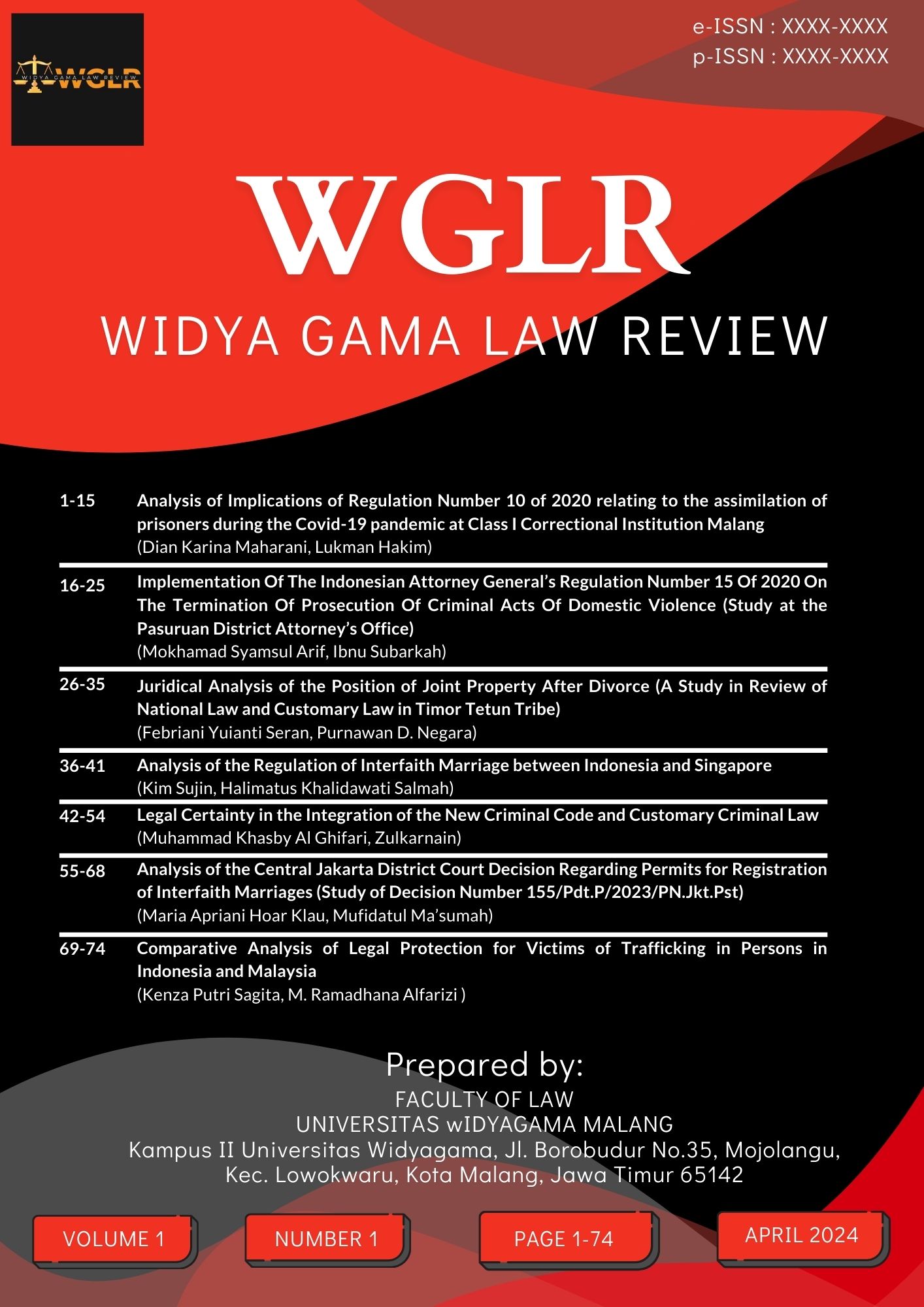Analysis of Implications of Regulation Number 10 of 2020 relating to the assimilation of prisoners during the Covid-19 pandemic at Class I Correctional Institution Malang
DOI:
https://doi.org/10.31328/wglr.v1i1.576Keywords:
Assimilation, Law Enforcement, Policy Implications , PrisonersAbstract
The controversy surrounding granting assimilation to prisoners due to prison capacity varies widely.
Prisoners who are released by assimilation are considered not ready to return to society, which is regarded as
causing new problems. This may lead to re-offending. Therefore, thisresearch investigates three main issues: First,
what is the impact of the government's assimilation policy implementation during the COVID-19 pandemic?
Second, what are the obstacles faced by prisoners of Class I Lowokwaru Correctional Institution in Malang in the
assimilation process? Third, the steps taken by the Class I Correctional Institution in Malang to implement
assimilation for these prisoners. To answer all the issues at hand and evaluate the impact of the Regulation, a
qualitative approach involving case studies was used. The results of this study show that the implementation has
two effects. First, although the implementation has a positive impact on the community outside the prison can
accept the policy and make it a deterrent, the number of criminal offenses increases due to the repetition of criminal
acts. Secondly, Malang's Class I Lowokwaru Correctional Institution faces problems with the lengthy screening
and supervision process after assimilation which is lacking across correctional institutions. Third, the Class I
Correctional Institution of Malang is trying to improve the supervision and sorting of inmates who are granted
assimilation so that they are returned to the community.
References
Ali, Zainuddin. Metode Penelitian Hukum. 1st ed. Jakarta: Sinar Grafika, 2009.
Anak Agung Gede Krisna. “Pendapat,” n.d.
Andriani, Sofia. “Wawancara, Di Bapas Kelas I Kota Malang, Pada Tanggal 8 Desember
,” 2021.
Ayuni, Qurrata, and Fitra Arsil. “Handling of Covid-19 as a Non-Natural Disaster in
Indonesia” 2019, no. 12 (2021). https://doi.org/10.4108/eai.18-11-2020.2311700.
Efendi, Jonaedi, et. al. “Metode Penelitian Hukum: Normatif Dan Empiris”,. Jakarta: Prenada
Media, 2016.
Fitriani, Ria, Luqman Hakim, and Oscar Radyan Danar. “Early Portraits of Government Policy in
Dealing with Covid-19 in Indonesia.” Jurnal Wacana 24, no. 2 (2021): 59–70.
Gao, Qijun, Yingfu Hu, Zhiguo Dai, Feng Xiao, Jing Wang, and Jing Wu. “The
Epidemiological Characteristics of 2019 Novel Coronavirus Diseases (COVID-19) in
Jingmen, China.” SSRN Electronic Journal 2, no. 8 (2020): 113–22.
https://doi.org/10.2139/ssrn.3548755.
Hardiyanto, Risyal. “‘Langkah-Langkah Strategis Untuk Mencegah Pandemi Covid 19 Di
Lembaga Pemasyarakatan Indonesia.’” Jurnal Pendidikan Kesehatan 9, no. 1 (2020).
KBBI. “Asimilasi,” n.d.
Li, Qun, Xuhua Guan, Peng Wu, Xiaoye Wang, Lei Zhou, Yeqing Tong, Ruiqi Ren, et al.
“Early Transmission Dynamics in Wuhan, China, of Novel Coronavirus–Infected
Pneumonia.” New England Journal of Medicine 382, no. 13 (2020): 1199–1207.
https://doi.org/10.1056/nejmoa2001316.
Medcom. “‘500 Narapidana Di Malang Dapat Asimilasi.’”
https://m.medcom.id/amp/zNAYLxZN-500-narapidana-di-malang-dapat-asimilasi;, n.d.
Moleong, L. Metode Penelitian Kualitatif. Bandung: PT. Remaja Rosdakarya, 2002.
PERMENKUMHAM. “PERMENKUMHAM Nomor 3 Tahun 2018 Tentang Syarat Dan Tata
Cara Pemberian Remisi, Asimilasi, Cuti Mengunjungi Keluarga, Pembebasan Bersyarat,
Cuti Menjelang Bebas Dan Cuti Bersyarat;,” 2018.
Purnomo, Abdi. “‘Asimilasi Covid-19 Lapas Lowokwaru Bebaskan 450 Narapidana.’”
http://nasional.tempo.co/read/1331608/asimilasi-covid-19-lapas-lowokwari-bebaskan450-narapidana.html, n.d.
Ramli, Muhammad. “‘Kearifan Lokal Dalam Implementasi Kebijakan Publik Perspektif Local
Wisdom Masyarakat Bugis.’” Makasar : Universitas Airlangga Press;, 2012.
Rosadi, Otong. “A History of COVID-19 Handling in Indonesia: A Review of Legal
Strategies.” Journal of Law and Sustainable Development 11, no. 11 (2023): e1663.
https://doi.org/10.55908/sdgs.v11i11.1663.
S Tua, Sahat Marull. “‘Pembebasan Narapidana Daalam Perspektif Konsep Asimilassi Di
Masa Pandemi Covid 19.’” Jurnal Litigasi 21, no. 2 (2020).
Syah, Azizan. “Analisis Yuridis Keputusan Menteri Hukum Dan HAM Tahun 2020 Tentang
Pengeluaran Dan Pembebasan Narapidana Dan Anak Melalui Asimilasi Dan Integrasi
Dalam Rangka Pencegahan Dan Penanggulangan Penyebaran Covid-19,” 2020.
Wiratmo, Dedi, Mutia Evi Kristhy, M. Nur Syam, and Agung Gunawan Putra. “Government
Policy Analysis in Health Crisis Conditions.” International Journal of Health Sciences 6,
no. 2 (2022): 920–30. https://doi.org/10.53730/ijhs.v6n2.8785.
Yosef Dhony Kristianto. “Wawancara, Di Polres Kota Malang, Pada Tanggal 19 November
,” 2021.
Downloads
Published
How to Cite
Issue
Section
License
Copyright (c) 2024 Dian Maharani, Lukman Hakim

This work is licensed under a Creative Commons Attribution-ShareAlike 4.0 International License.





